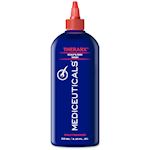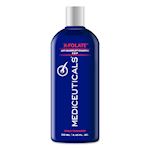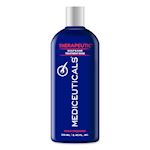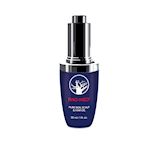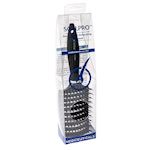-
LICHEN PLANOPILARIS: HAIR LOSS DUE TO INFLAMMATION
Do you suffer from hair loss around your crown, at the front or sides of your head? Does the skin where the hair falls feel smooth and are there no more visible hair follicle openings? Then there is a good chance that you are dealing with lichen planopilaris. Especially if the skin around the hair follicles is red and flaking. This indicates an inflammation. That is exactly what is happening with lichen planopilaris. The hair follicles are inflamed and this causes the hair to fall out. In addition, the inflammation causes scarring of the hair follicles, which prevents new hair from growing.
-
WHAT IS LICHEN PLANOPILARIS?
Lichen planopilaris is an autoimmune disease that mainly affects women between the ages of 40 and 60. That does not mean that men or people under 40 do not suffer from it. It just happens much less often. The disease is extremely rare in children.
Lichen planopilaris always involves inflammation of the hair follicles. These cause hair loss and scarring. However, three different types of lichen planopilaris can be distinguished:
Classical lichen planopilaris
In classic lichen planopilaris, the hair usually falls out on the top of the head on the crown. From there it spreads to the edges of the head. In some people with classic lichen planopilaris, the hair from the eyebrows and armpits also falls out. In the acute stage (when the hair follicles are inflamed) you may see pimples, flaking and a purple/red discoloration around the hair follicles. Itching and a burning sensation are a common complaint. The hairs on the edges are easy to pull out if the process is still active. Scars appear at a later stage. Once the hair falls out, the openings of the hair follicles are covered with scar tissue and no more hair can grow. The scalp is completely smooth in these areas. Sometimes a few hairs remain on the otherwise bald spots.
Frontal fibrosing alopecia
Frontal Fibrosing Alopecia (FFA) is characterized by hair loss on the front or sides of the head. About half of all people affected by this condition also experience eyebrow hair loss. Sometimes even the eyelash hairs fall out. Some people with FFA also develop hair loss in areas other than the scalp and face.
Graham Little-Piccardi-Lasseur syndrome
Graham Little-Piccardi-Lasseur syndrome (GLPLS) is a rare variant of lichen planopilaris. It is characterized by progressive hair loss on the crown with scarring and thinning hair in the armpits. With the latter, there is no scarring. In addition, hair follicles all over the body may become red and flake.
WHAT CAUSES LICHEN PLANOPILARIS?
The exact underlying cause of lichen planopilaris is unknown. Currently, doctors believe it is an autoimmune disease in which a person's immune system accidentally attacks the hair follicles. The hair loss is the result of inflammation of the hair follicles.
Unfortunately, hair loss is permanent. This is because the inflammation causes scarring in the hair follicles. Scientists also suspect there may be a hormonal component, as the condition is most common in women over the age of 50 who have already gone through menopause.
CAN LICHEN PLANOPILARIS BE TREATED?
Unfortunately, lichen planopilaris is currently difficult to treat. It is therefore a diagnosis that you would rather not receive. There are scalp treatments such as creams, lotions and gels that are worth trying. Hormone injections also have a positive effect on some patients. If there is no effect, doctors sometimes prescribe antibiotic tablets. Some patients benefit from anti-malarial medications. It is often a search for what works best for you. To this day, no therapy or medicine works and has an effect on all patients.
With lichen planopilaris it is especially important to be there on time. The annoying thing is that the hair that falls out does not grow back. This is due to the scar tissue that forms in the hair follicles due to inflammation. This causes the hair follicles to disappear. Without hair follicles, hair growth is no longer possible. That is why it is important to inhibit or slow down the disease as quickly and effectively as possible.
THE IMPORTANCE OF A HEALTHY SCALP
It may take some time before a doctor finds the most effective treatment method for lichen planopilaris. That is annoying because quick action is so important with this disease. It is important to ensure that as little hair falls out as possible. The advice is therefore to switch to hair care products that inhibit or slow down hair loss immediately after the diagnosis.
Mediceuticals products contribute to a healthy scalp and hair growth. We recommend products from the Scalp Therapies line for the treatment of lichen planopilaris. It contains ingredients that inhibit inflammation in the hair follicles. The treatment always consists of 3 steps. First, apply the Therarx to the (dry) scalp without adding water and let it work for 1 to 2 minutes (this step a maximum of twice a week). After wetting the hair, apply the X-Folate shampoo directly over the Therarx. Massage the shampoo and let it work for 2 to 3 minutes. After rinsing the shampoo, towel dry the hair and use the Therapeutic conditioner. You should also leave the conditioner on for 2 to 3 minutes before rinsing.
WHAT HAPPENS NEXT?
As if hair loss wasn't bad enough, the hair with lichen planopilaris also no longer grows back. And because you only discover what exactly is going on when hair falls out, you have always already lost some of your hair. To fix that, you have a few options. This makes it possible to cover bald spots with a hairpiece or wig. A hairpiece specialist can put together both a temporary and permanent hairpiece for you. This is done with so much specialism and care that it is not visible at all that it is a hairpiece when worn.
Another option is a hair transplant. This does require that the lichen planopilaris is under control. The advice is often to first have a test piece treated to see what the effect is. Scar formation causes poorer blood circulation and damages the skin, so the results of a transplant are not always certain in advance. The results of a hair transplant are in principle permanent, but you must keep in mind that the lichen planopilaris can also inflame the new hair follicles. The use of the right hair care products therefore always remains important.
-
DO YOU WANT MORE INFORMATION ABOUT MEDICEUTICALS?
For personal advice you can contact us or make an appointment at one of our certified Mediceuticals salons.




